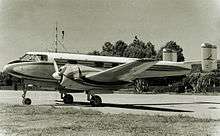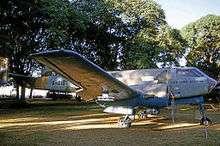DINFIA IA 35
| IA 35 Huanquero | |
|---|---|
 | |
| Role | Twin-engine utility aircraft |
| Manufacturer | DINFIA |
| Designer | Kurt Tank |
| First flight | 1953 |
| Introduction | 1957 |
| Primary user | Argentine Air Force |
| Number built | 50+ |
|
| |
The DINFIA IA 35 Huanquero was a 1950s Argentine twin-engined general-purpose monoplane aircraft built by the DINFIA.
Development
The IA 35 Huanquero was the first aircraft design from the DINFIA organisation (Argentina) to enter production. A twin-engined all-metal (except for fabric-covered ailerons) low-wing cantilever monoplane, it had a high-mounted tailplane with two fins and rudders and retractable tricycle landing gear. It was powered by two I.Ae. 19R El Indio[1] radial engines.
The design team was led by professor Kurt Tank, former Focke Wulf designer who also designed the Pulqui II jet fighter based on the Focke-Wulf Ta 183 of the World War II era.
The prototype first flew on 21 September 1953 and was followed by a planned production batch of 100 aircraft.[2] The first production aircraft flew on 29 March 1957[2] but less than half of the aircraft were built when production ceased in the mid-1960s.
Variants

- IA 35 Type 1A
- Advanced instrument or navigation trainer, powered by two IA 19R El Indio radial engines.
- IA 35 Type 1U
- Bombing and gunnery trainer, powered by two 750hp (559kW) IA 19SR1 El Indio radial engines.
- IA 35 Type II
- Light transport version with a crew of three and seven passengers, powered by two IA 19R El Indio radial engines.
- IA 35 Type III
- Air ambulance version with a crew of three and four stretchers with attendants, powered by two IA 19R El Indio radial engines.
- IA 35 Type IV
- Photographic reconnaissance version with crew of three and camera operator, powered by two IA 19R El Indio radial engines.
- Constancia II
- Projected version with Turbomeca Bastan turboprops.
- Pandora
- Civil transport version with room for ten passengers, powered by two 750hp (559kW) IA 19SR1 El Indio radial engines.
Survivors

- Huanquero A-316 (ex-Argentine Air Force) is preserved at the Museo Nacional de Aeronautica, Morón, Buenos Aires, Argentina.[3]
Operators
Specifications (IA 35 Type 1A)
Data from Jane's All The World's Aircraft 1961–62[4]
General characteristics
- Crew: eight (pilot, co-pilot, radio operator, instructor and four pupils)
- Length: 13.98 m (45 ft 10 in)
- Wingspan: 19.6 m (64 ft 4 in)
- Wing area: 42.0 m2 (452 sq ft)
- Aspect ratio: 9:1
- Airfoil: NACA 633-218 at root, NACA 631-212 at tip
- Empty weight: 3,500 kg (7,716 lb)
- Gross weight: 5,700 kg (12,566 lb)
- Fuel capacity: 1,200 L (143 Imp Gall)
- Powerplant: 2 × IA 19R El Indio 9-cylinder air-cooled radial engines, 460 kW (620 hp) each
- Propellers: three-bladed Rotol
Performance
- Maximum speed: 362 km/h (225 mph; 195 kn) at 3,000 m (9,840 ft)
- Cruising speed: 320 km/h (199 mph; 173 kn) at 300 m (980 ft) (econ cruise)
- Range: 1,570 km (976 mi; 848 nmi)
- Endurance: 4 hr 40 min
- Service ceiling: 6,400 m (20,997 ft)
- Rate of climb: 5.00 m/s (984 ft/min)
See also
- Related development
- IA 35 Guaraní I
- FMA IA 50 Guaraní II
References
- Notes
- Bibliography
- Ogden, Bob, Aviation Museums and Collections of the rest of the World, 2008, Air-Britain (Historians) Ltd, Tonbridge, Kent, ISBN 978-0-85130-394-9.
- Taylor, John W. R. Jane's All The World's Aircraft 1965-66. London: Sampson Low, Marston, 1965.
- The Illustrated Encyclopedia of Aircraft (Part Work 1982–1985), 1985, Orbis Publishing
External links
| Wikimedia Commons has media related to DINFIA IA 35. |